英语教学设计与技能训练综合练习及答案
- 格式:doc
- 大小:39.00 KB
- 文档页数:8
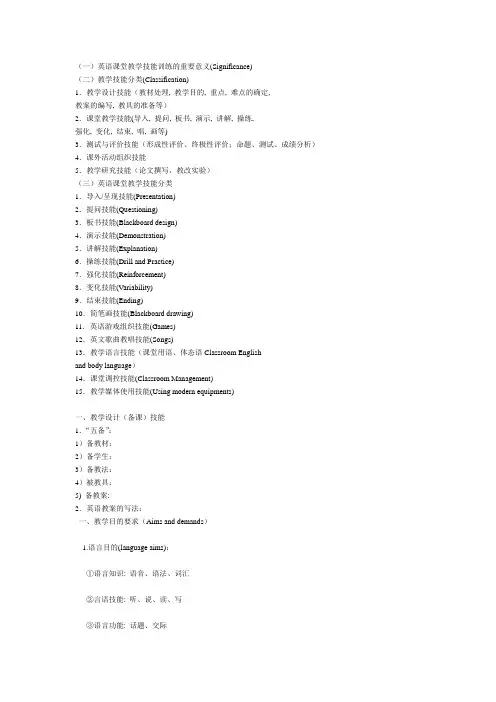
(一)英语课堂教学技能训练的重要意义(Significance)(二)教学技能分类(Classification)1.教学设计技能(教材处理, 教学目的, 重点, 难点的确定,教案的编写, 教具的准备等)2.课堂教学技能(导入, 提问, 板书, 演示, 讲解, 操练,强化, 变化, 结束, 唱, 画等)3.测试与评价技能(形成性评价、终极性评价;命题、测试、成绩分析)4.课外活动组织技能5.教学研究技能(论文撰写,教改实验)(三)英语课堂教学技能分类1.导入/呈现技能(Presentation)2.提问技能(Questioning)3.板书技能(Blackboard design)4.演示技能(Demonstration)5.讲解技能(Explanation)6.操练技能(Drill and Practice)7.强化技能(Reinforcement)8.变化技能(Variability)9.结束技能(Ending)10.简笔画技能(Blackboard drawing)11.英语游戏组织技能(Games)12.英文歌曲教唱技能(Songs)13.教学语言技能(课堂用语、体态语Classroom Englishand body language)14.课堂调控技能(Classroom Management)15.教学媒体使用技能(Using modern equipments)一、教学设计(备课)技能1.“五备”:1)备教材:2)备学生:3)备教法:4)被教具:5) 备教案:2.英语教案的写法:一、教学目的要求(Aims and demands)1.语言目的(language aims):①语言知识: 语音、语法、词汇②言语技能: 听、说、读、写③语言功能: 话题、交际2.思想目的(Moralaims):结合课文内容进行思想品德情感教育3.智力目的(Intelligenceaims):自学、观察、思维、记忆、归纳等能力二、教学内容(Contents):语音、语法、词汇、句型、语言功能三、教学重点(Key points/Focus)四、教学难点(Difficult points)五、教学用具(Teachingaids):录音机、磁带、实物、挂图、图片、卡片、小黑板等六、教学过程(Teaching procedure)1.组织教学(Getting organized/Warming up)(2 mins)1)师生问候(Greetings)2)值日生报告(Daily report)3)自由谈话(Free talk)4)交待本节任务(Task of the period)2.复习检查(Revision)(5mins)1) 复习上节所学内容(快速口头复习为住)2) 检查上节布置的作业(口、笔头)3.呈现/介绍/导入(Presentation)(8 mins)1)以旧引新或直观导入(实物、图片、卡片、简笔画、动作、表情、情景)2)引导、启发学生进行观察、分析、对比,从音、形、义上感知新材料4。
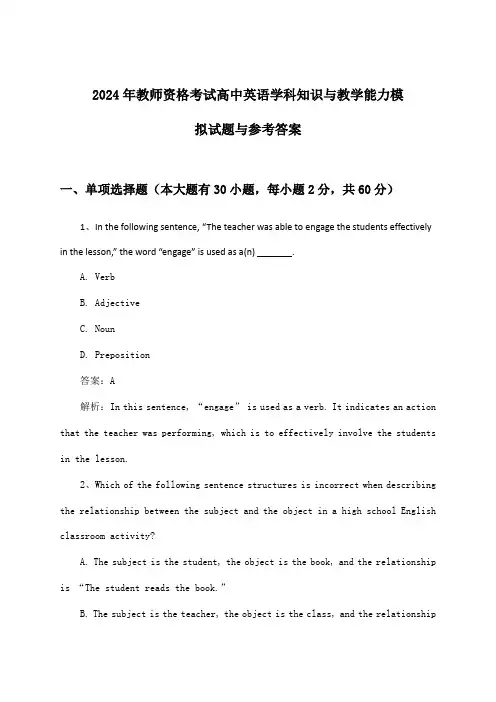
2024年教师资格考试高中英语学科知识与教学能力模拟试题与参考答案一、单项选择题(本大题有30小题,每小题2分,共60分)1、In the following sentence, “The teacher was able to engage the students effectively in the lesson,” the word “engage” is used as a(n) _______.A. VerbB. AdjectiveC. NounD. Preposition答案:A解析:In this sentence, “engage” is used as a verb. It indicates an action that the teacher was performing, which is to effectively involve the students in the lesson.2、Which of the following sentence structures is incorrect when describing the relationship between the subject and the object in a high school English classroom activity?A. The subject is the student, the object is the book, and the relationship is “The student reads the book.”B. The subject is the teacher, the object is the class, and the relationshipis “The teacher teaches the class.”C. The subject is the group, the object is the project, and the relationship is “The group completes the project.”D. The subject is the student, the object is the assignment, and the relationship is “The student hands in the assignment.”答案:B解析:Option B is incorrect because it incorrectly describes the relationship. The correct structure should be “The teacher teaches the students,” where “students” is the object that is being taught. The use of “the class” as the object is grammatically incorrect in this context.3、Which of the following strategies is most effective for teaching vocabulary to high school English students?A、Providing students with a large number of examples and definitionsB、Encouraging students to memorize word listsC、Using context clues and word formation techniquesD、Focusing solely on translation exercisesAnswer: CExplanation: Encouraging students to use context clues and word formation techniques (Option C) helps them develop a deeper understanding of vocabulary. This method encourages active learning and critical thinking, which are valuable for long-term retention and application of vocabulary.4、When designing a lesson plan for teaching a complex literary text, whichof the following is the most appropriate order of activities?A、Discussion of literary elements, classroom quiz, individual reading of the text, group presentationB、Reading the text, highlighting important sections, discussion, vocabulary practice, summarizationC、Vocabulary practice, group discussion, individual reading of the text, writing a responseD、Pre-reading introduction, close reading with analysis, group discussion, reflectionAnswer: DExplanation: The most appropriate order for teaching a complex literary text is to begin with a pre-reading introduction to set the context and build prior knowledge. This is followed by a close reading of the text with analysis to examine literary elements and techniques. Group discussion allows for collaborative learning and deeper understanding, and reflection helps consolidate and apply the learning.5、The prefix “dis-” means “not.” Which word does NOT mean “happy” when the prefix is added?A. fortunateB. contentC. pleasantD. delightedAnswer: AExplanation: The prefix “dis-” changes the meaning of “fortunate,” making it “unfortunate” or not fortunate, which does not mean “happy.” The words “content” and “delighted” have a positive connotation and still refer to a state of being happy. The word “pleasant” means enjoyable or agreeable and defines a pleasurable feeling but is not transformed by the prefix “dis-.”6、In the sentence “They had the intention of revising their strategies,” which part of speech is “revise”?A. VerbB. NounC. AdjectiveD. AdverbAnswer: AExplana tion: “Revise” is the base form of a verb and is serving as the main verb in the sentence. It expresses an action or a state of action done by the subject “They.” It is not a noun, adjective, or adverb in this context.7、In the following sentence, which word is a demonstrative pronoun?A. That book is on the table.B. This pen is mine.C. The book on the table is mine.D. Whose book is on the table?Answer: CExplanation: “The” is a demonstrative pronoun that refers to a specific object already mentioned or easily identified. In this case, it refers back to the “book” mentioned in the second part of the sentence.8、Which of the following sentence structures is used to show comparison between two things?A. I like apples more than bananas.B. I like apples as well as bananas.C. I like apples because they are delicious.D. I like apples, and so do you.Answer: AExplanation: Sentence A uses the structure “more than,” which is commonly used to show comparison between two things. The other options do not expressa direct comparison.9、Which of the following statements is an effective way to introduce a new topic in a high school English class?A、Ask students to write a short summary of the last lesson.B、Start with a discussion on a relevant, everyday topic.C、Give out a set of questions related to the next lesson.D、Show a video or a clip to capture students’ attention.Correct Answer: B解析:选项B是一个有效引入新话题的方法,通过讨论一个相关且贴近生活的主题,可以激发学生的兴趣和参与感。
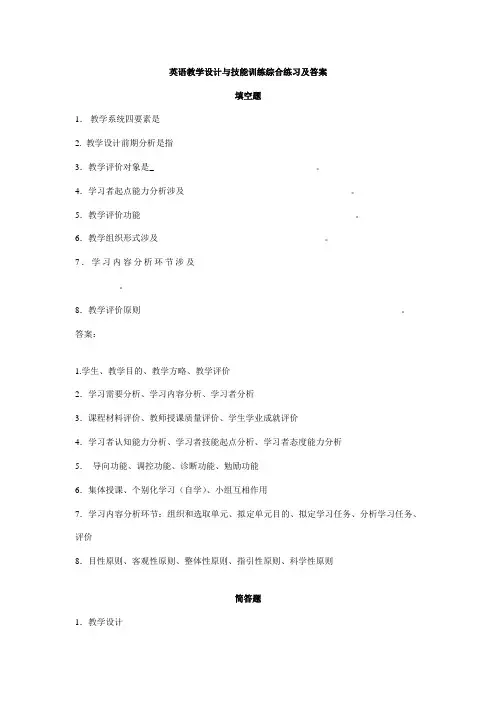
英语教学设计与技能训练综合练习及答案填空题1.教学系统四要素是___________ ___________ ____________ ___________2. 教学设计前期分析是指___________ ___________ ____________3.教学评价对象是___________ ___________ ____________。
4.学习者起点能力分析涉及__________ ___________ ____________ 。
5.教学评价功能_________ ___________ ____________ ___________。
6.教学组织形式涉及__________ ___________ ____________ 。
7.学习内容分析环节涉及_________ ___________ ____________ ___________ __________。
8.教学评价原则_________ ___________ ____________ ___________ __________。
答案:1.学生、教学目的、教学方略、教学评价2.学习需要分析、学习内容分析、学习者分析3.课程材料评价、教师授课质量评价、学生学业成就评价4.学习者认知能力分析、学习者技能起点分析、学习者态度能力分析5.导向功能、调控功能、诊断功能、勉励功能6.集体授课、个别化学习(自学)、小组互相作用7.学习内容分析环节:组织和选取单元、拟定单元目的、拟定学习任务、分析学习任务、评价8.目性原则、客观性原则、整体性原则、指引性原则、科学性原则简答题1.教学设计2.教学阶段涉及哪些?3.学习需要4.学习阶段5.学习风格6.教学方略答案1.运用系统办法分析教学问题和拟定教学目的、建立解决教学问题方略方案、试行解决方案、评价试行成果和对方案进行修改过程。
它以优化教学效果为目,以学习理论、教学理论和传播学为理论基本。
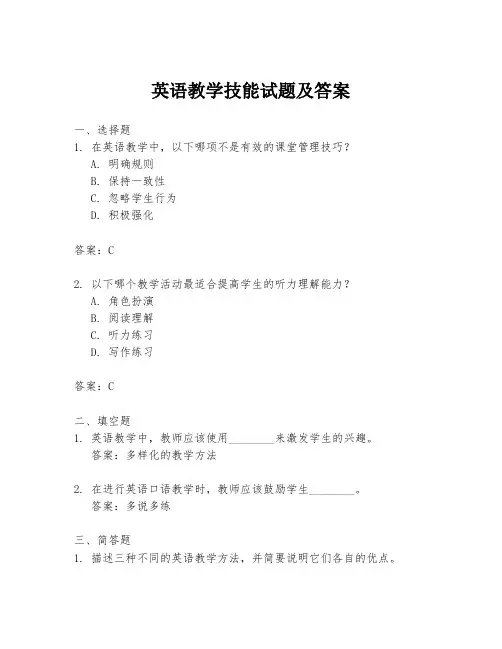
英语教学技能试题及答案一、选择题1. 在英语教学中,以下哪项不是有效的课堂管理技巧?A. 明确规则B. 保持一致性C. 忽略学生行为D. 积极强化答案:C2. 以下哪个教学活动最适合提高学生的听力理解能力?A. 角色扮演B. 阅读理解C. 听力练习D. 写作练习答案:C二、填空题1. 英语教学中,教师应该使用________来激发学生的兴趣。
答案:多样化的教学方法2. 在进行英语口语教学时,教师应该鼓励学生________。
答案:多说多练三、简答题1. 描述三种不同的英语教学方法,并简要说明它们各自的优点。
- 方法一:任务型教学。
优点是能够提高学生的实践能力,使学生在完成任务的过程中学习语言。
- 方法二:交际教学法。
优点是强调语言的实际使用,鼓励学生在真实或模拟的交际情境中使用英语。
- 方法三:语法翻译法。
优点是有助于学生深入理解语言结构,适合语法概念的学习。
四、论述题1. 论述在英语教学中如何平衡语言知识的传授和语言技能的培养。
答案:在英语教学中,平衡语言知识的传授和语言技能的培养可以通过以下方式实现:- 整合教学:将语法、词汇等语言知识与听说读写等语言技能的教学相结合。
- 任务驱动:设计以任务为基础的学习活动,让学生在完成任务的过程中自然地运用和学习语言。
- 反馈机制:提供及时和具体的反馈,帮助学生理解语言知识的运用并改进语言技能。
- 个性化教学:根据学生的需求和兴趣调整教学内容和方法,以激发学生的学习动力。
五、案例分析题1. 阅读下面的教学案例,分析教师在教学过程中可能遇到的问题,并提出改进建议。
案例:一位英语教师在教授新词汇时,只是简单地列出单词和它们的意思,然后要求学生背诵。
答案:- 学生可能对单词的理解不够深入,无法在实际语境中正确使用。
- 缺乏互动和实践,学生可能感到枯燥,影响学习兴趣。
改进建议:- 结合语境教授词汇,例如通过句子或对话来展示单词的用法。
- 采用游戏或小组活动,增加学生之间的互动,提高学习的趣味性。

第1篇IntroductionThe following teaching design is tailored for a middle school English class, focusing on a unit about "Hobbies and Interests." The lesson aims to enhance students' speaking and listening skills while fostering their ability to express their own hobbies and interests. The target age group is 13-15 years old, and the class duration is 45 minutes.Objective1. Knowledge Objective: Students will be able to understand and use key vocabulary related to hobbies and interests.2. Skill Objective: Students will be able to engage in a conversation about their hobbies and interests with their peers.3. Emotional Objective: Students will develop an interest in exploring and sharing their personal hobbies and interests.Teaching Aids- Whiteboard- Projector- Handouts with vocabulary and questions- Audio recording of a conversation about hobbies- Pen and paper for individual activitiesTeaching Procedure1. Warm-up (5 minutes)- Activity: Brainstorming- Ask students to write down their favorite hobbies on the board.- Encourage them to share their hobbies with the class and explain why they enjoy them.2. Presentation (10 minutes)- Activity: Vocabulary Presentation- Introduce key vocabulary related to hobbies and interests (e.g., collect, paint, read, play music, travel).- Use pictures and real-life examples to illustrate the meanings of the words.- Have students practice using the new vocabulary in sentences.3. Practice (15 minutes)- Activity: Role Play- Pair students up and give them a handout with a conversation about hobbies.- Ask them to read the conversation and practice it with their partner.- Monitor and provide feedback on their pronunciation and fluency.- Activity: Group Discussion- Divide the class into small groups.- Provide each group with a list of questions related to hobbies and interests.- Ask the groups to discuss the questions and share their opinions.4. Production (10 minutes)- Activity: Personal Hobbies Interview- Pair students up again.- Each student interviews their partner about their hobbies and interests using the questions provided.- The other student listens carefully and takes notes.- After the interview, the pair swaps roles.5. Assessment (5 minutes)- Activity: Quick Write- Ask students to write a short paragraph about their favorite hobby, using the new vocabulary and structure learned in the lesson.- Collect the writings for assessment.Conclusion- Activity: Sharing and Reflection- Ask students to share their favorite hobby with the class.- Encourage them to reflect on what they learned during the lesson and how they can incorporate their new vocabulary and skills into theirdaily lives.Feedback and ReflectionAt the end of the lesson, collect feedback from students regarding their learning experience. Reflect on the effectiveness of the teaching methods used and identify areas for improvement. Consider the following questions:- Did the students engage actively in the activities?- Did the vocabulary and skills presented align with the learning objectives?- Were the activities appropriate for the age and level of the students?- How can the lesson be adapted to better suit the needs of the students?ConclusionThis practical English teaching design aims to provide a structured and engaging lesson that enhances students' language skills while fostering their personal interests. By incorporating various activities and allowing for individual expression, the lesson encourages students todevelop a love for learning and a deeper understanding of the English language.第2篇Objective:The primary objective of this English teaching design is to enhance students' proficiency in English by integrating technology into the classroom. This approach aims to make learning more engaging, interactive, and effective, while also preparing students for the digital age.Target Audience:This lesson plan is designed for secondary school students in grades 9-12, with a focus on improving their reading, writing, speaking, and listening skills.Duration:One hour per session, for a total of 10 sessions over a month.Materials:- Interactive whiteboard or projector- Computers or tablets for each student- Internet access- Online learning platforms (e.g., Google Classroom, Edmodo)- Textbooks and supplementary reading materials- Flashcards- Markers and whiteboard erasersLesson Overview:The lesson will be divided into four main sections: Warm-up, Introduction, Activity, and Conclusion. Each section will incorporate technology to enhance the learning experience.1. Warm-up (10 minutes):- Activity: Use a PowerPoint presentation to display a series ofpictures related to the upcoming topic. Students will be asked to describe the pictures using complete sentences in English.- Technology Integration: Utilize the interactive whiteboard to allow students to contribute their descriptions directly onto the board.2. Introduction (10 minutes):- Activity: Introduce the new topic by showing a short video clip or a related news article. This will provide context and pique students' interest.- Technology Integration: Use a computer or tablet to project the video or article onto the screen. Encourage students to take notes on key points.3. Activity (30 minutes):- Activity: Divide the class into small groups and assign each group a different task using online learning platforms.- Group 1: Research a specific topic related to the lesson and create a presentation using Google Slides.- Group 2: Write a short story or a poem based on the lesson's theme and post it on a class blog using WordPress.- Group 3: Record a video discussing their understanding of the topic and upload it to a video sharing platform like YouTube.- Group 4: Create a mind map or Venn diagram comparing and contrasting two related topics using an online tool like XMind.- Technology Integration: Provide each group with a computer or tablet and internet access. Encourage students to collaborate and share their work online.4. Conclusion (10 minutes):- Activity: Bring the class back together to share their findings and discuss the common themes they noticed.- Technology Integration: Use the interactive whiteboard to display the groups' presentations, stories, videos, or mind maps. Have each group present their work and invite the class to ask questions or provide feedback.Assessment:- Formative Assessment: Monitor student participation during the activities and provide feedback on their progress.- Summative Assessment: At the end of the unit, administer a writtentest or an oral presentation to evaluate students' understanding of the key concepts.Reflection and Adaptation:- Reflection: After the completion of the lesson, reflect on the effectiveness of integrating technology into the classroom. Consider what worked well and what could be improved.- Adaptation: Adjust the lesson plan as needed to better suit the students' needs and preferences. For example, if a particular activity was not well-received, consider modifying it for the next session.Conclusion:This practical design for English language teaching demonstrates how technology can be effectively integrated into the classroom to enhance the learning experience. By incorporating various digital tools and platforms, teachers can create a more engaging, interactive, and effective learning environment that prepares students for the challenges of the digital age.第3篇IntroductionThe purpose of this English teaching design is to create an engaging and interactive learning environment that incorporates technology to enhance the learning experience of students. This case study focuses on a secondary school English class in China, where the target group is students in Grade 8. The lesson aims to improve students' reading comprehension and vocabulary acquisition skills through the use ofdigital tools and multimedia resources.ObjectiveBy the end of the lesson, students will be able to:1. Comprehend the main ideas and details of a given text.2. Expand their vocabulary through the use of digital dictionaries and interactive games.3. Develop critical thinking skills by analyzing and evaluating the content of the text.4. Demonstrate their understanding of the text through various forms of digital presentations.Materials and Resources1. Interactive whiteboard or computer projector.2. Projector-connected laptop with internet access.3. Digital dictionaries (e.g., Oxford Dictionaries Online).4. Vocabulary-building apps (e.g., Quizlet, Anki).5. Online reading materials (e.g., articles, stories, videos).6. Presentation software (e.g., PowerPoint, Google Slides).7. Handouts with text excerpts and questions.Teaching Procedure1. Warm-up (5 minutes)- Begin the lesson with a quick review of the previous lesson's vocabulary using a digital dictionary.- Engage students in a brief discussion about their weekendactivities using a digital platform (e.g., Padlet) to encourage interaction and participation.2. Introduction (5 minutes)- Introduce the theme of the lesson and the text to be studied using a digital presentation.- Highlight the learning objectives and expectations for the students.3. Pre-reading (10 minutes)- Use a digital platform to show a related video or image to activate prior knowledge and generate interest in the topic.- Distribute handouts with a few questions about the text to be studied. Encourage students to discuss their predictions with a partner.4. Reading (20 minutes)- Project the text on the interactive whiteboard or computer screen.- Divide the text into sections and have students read silently or in pairs.- Use a digital dictionary to look up any unfamiliar vocabulary words.- Encourage students to take notes on key information and main ideas.5. Comprehension Check (10 minutes)- Use a digital platform (e.g., Kahoot!, Quizizz) to assess students' understanding of the text.- Review the answers and discuss any misconceptions or difficult concepts.6. Vocabulary Building (15 minutes)- Introduce new vocabulary words related to the text using a vocabulary-building app.- Have students practice using the new words in sentences or complete exercises on the interactive whiteboard.7. Critical Thinking (10 minutes)- Present a series of questions or prompts that require students to analyze and evaluate the content of the text.- Encourage students to share their opinions and support their arguments with evidence from the text.8. Presentation (10 minutes)- Have students work in groups to create a digital presentation (e.g., using PowerPoint or Google Slides) summarizing their understanding ofthe text.- Allow each group to present their findings to the class.9. Closing (5 minutes)- Conclude the lesson by summarizing the main points discussed andthe new vocabulary introduced.- Assign homework that includes further reading and vocabulary practice.Assessment1. Formative Assessment:- Observe students' participation in discussions and group activities.- Monitor students' use of digital tools and resources during the lesson.- Use digital platforms to assess students' understanding of the text and vocabulary.2. Summative Assessment:- Evaluate students' digital presentations and their ability to summarize the text.- Assign a reflective essay or journal entry where students can express their thoughts on the text and the use of technology in the classroom.ConclusionThis English teaching design incorporates technology to create a dynamic and interactive learning environment that supports students' reading comprehension and vocabulary acquisition skills. By utilizing digital tools and resources, students are able to engage with the material in new and exciting ways, enhancing their learning experience and promoting critical thinking skills.。
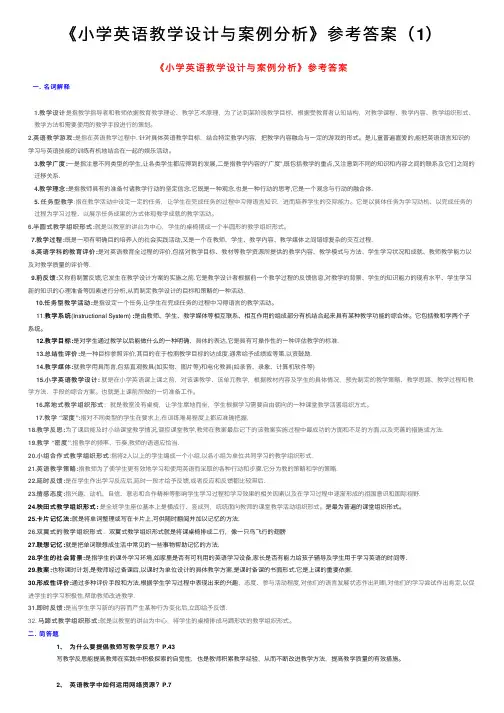
《⼩学英语教学设计与案例分析》参考答案(1)《⼩学英语教学设计与案例分析》参考答案⼀.名词解释1.教学设计是指教学指导者和教师依据教育教学理论、教学艺术原理,为了达到某阶段教学⽬标,根据受教育者认知结构,对教学课程、教学内容、教学组织形式、教学⽅法和需要使⽤的教学⼿段进⾏的策划。
2.英语教学游戏:是指在英语教学过程中,针对具体英语教学⽬标,结合特定教学内容,把教学内容融合与⼀定的游戏的形式。
是⼉童普遍喜爱的,能把英语语⾔知识的学习与英语技能的训练有机地结合在⼀起的娱乐活动。
3.教学⼴度:⼀是指注意不同类型的学⽣,让各类学⽣都应得到的发展,⼆是指教学内容的”⼴度”,既包括教学的重点,⼜注意到不同的知识和内容之间的联系及它们之间的迁移关系.4.教学理念:是指教师具有的准备付诸教学⾏动的坚定信念.它既是⼀种观念,也是⼀种⾏动的思考,它是⼀个观念与⾏动的融合体.5.任务型教学:指在教学活动中设定⼀定的任务,让学⽣在完成任务的过程中习得语⾔知识,进⽽培养学⽣的交际能⼒。
它是以具体任务为学习动机、以完成任务的过程为学习过程、以展⽰任务成果的⽅式体现教学成就的教学活动。
6.半圆式教学组织形式:就是以教室的讲台为中⼼,学⽣的桌椅摆成⼀个半圆形的教学组织形式。
7.教学过程:既是⼀项有明确⽬的培养⼈的社会实践活动,⼜是⼀个在教师、学⽣、教学内容、教学媒体之间错综复杂的交互过程.8.英语学科的教育评价:是对英语教育全过程的评价,包括对教学⽬标、教材等教学资源所提供的教学内容、教学模式与⽅法、学⽣学习状况和成就、教师教学能⼒以及对教学质量的评价等.9.前反馈:⼜称前制置反馈,它发⽣在教学设计⽅案的实施之前.它是教学设计者根据前⼀个教学过程的反馈信息,对教学的背景、学⽣的知识能⼒的现有⽔平、学⽣学习新的知识的⼼理准备等因素进⾏分析,从⽽制定教学设计的⽬标和策略的⼀种活动.10.任务型教学活动:是指设定⼀个任务,让学⽣在完成任务的过程中习得语⾔的教学活动。
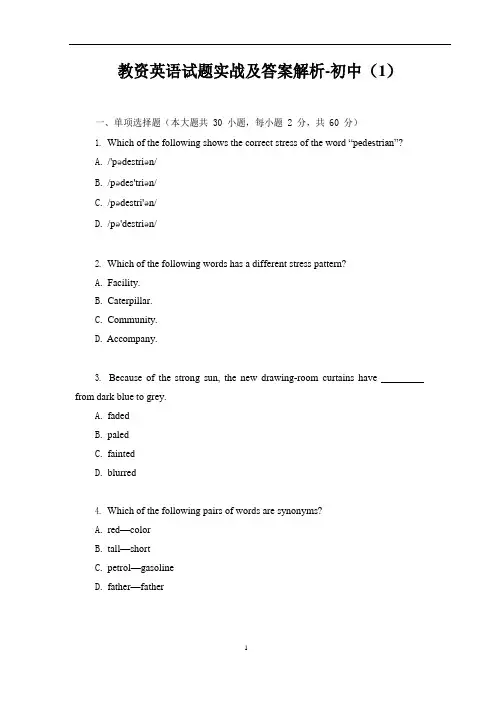
教资英语试题实战及答案解析-初中(1)一、单项选择题(本大题共 30 小题,每小题 2 分,共 60 分)1.Which of the following shows the correct stress of the word “pedestrian”?A./'pədestriən/B./pədes'triən/C./pədestri'ən/D./pə'destriən/2.Which of the following words has a different stress pattern?A.Facility.B.Caterpillar.munity.D.Accompany.3.Because of the strong sun, the new drawing-room curtains have from dark blue to grey.A.fadedB.paledC.faintedD.blurred4.Which of the following pairs of words are synonyms?A.red—colorB.tall—shortC.petrol—gasolineD.father—father5.We don't know what experiment those researchers would on females to test this hypothesis.A.applyB.carryC.deliverD.perform6.Tom said he would go to Hong Kong for winter vacation and he go.A.didB.hadC.doesD.will7.It is forbidden faster than 60 km/h on this highway.A.to drivingB.to driveC.being drivenD.to be driven8.In the sentence “It’s no use crying over the spilt milk”, the italicized part is.A.an objectB.an adverbialC.a subjectD.a complement9.Which of the following describes the function of the sentence “It is a nice day, isn't it”?rmative.B.Phatic.C.Directive.D.Performative.10.Which of the following describes the process in which one's language ability is developed in natural and everyday situation?A.Performance.petence.C.Learning.D.Acquisition.11.What role does he/she play when a teacher explains the purpose of a task, the steps to do it and its time limit?A.An organizer.B.An observer.C.An evaluator.D.A prompter.12.What does he/she intend to do when a teacher writes the following sentences “She gets up early. She wears a uniform. She works very hard.” on the blackboard at the presentation stage?A.Practicing sentence patterns using model sentences.B.Checking if students can pronounce the sentences correctly.C.Monitoring whether students can accurately express their ideas.D.Drawing students’ attention to the form of a new language item.13.W hat skill does he/she use when a student uses language knowledge and contextual clues to figure out the meaning of a new word?A.Contrasting.B.Summarizing.C.Deducing.D.Predicting.考点:语言教学知识与能力-词汇教学14.S upplementing, deleting, simplifying and reordering are often used in.A.adapting teaching materialsB.delivering teaching materialsC.evaluating teaching materialsD.presenting teaching materials考点:教学常识--教材编写与修订15.W hich of the following is least recommended at the lead-in stage in a reading class?A.Activating students' schema of the topic.B.Giving advice on how to use reading strategies.C.Sharing background information about the text.D.Correcting language mistakes students have made.考点:语言教学知识与能力--阅读教学16.W hich of the following best describes the phenomenon that learners apply the skills acquired in one field to another?A.Transfer.B.Deduction.C.Contextualization.D.Induction.考点:学习方法17.I f the focus is placed on , students are supposed to go through the stages of drafting, receiving feedback, and revising before submitting the final version of their writings.A.productB.processC.genreD.format考点:语言教学知识与能力--写作教学18.W hat would he/she do in a reading class if a teacher wants to develop students' inferential comprehension?A.Asking them to retell the story.B.Asking them to underline difficult sentences.C.Asking them to read the text sentence by sentence.D.Asking them to read the text for implied meaning.考点:语言教学知识与能力--阅读教学19.W hich of the following activities can be used if the focus is on developing students' oral fluency in English?A.Blank-filling.B.Story-telling.C.Transformation.D.Translation.考点:语言教学知识与能力--口语教学20.W hat is the focus when a teacher says to the class “ Rewrite each of the following sentences using the passive voice.”?A.Skill.B.Meaning.C.Structure.D.Function.考点:语言教学知识与能力--语法教学考点归纳二、简答题(本大题 1 小题,20 分)根据题目要求完成下列任务,用中文作答。

《英语学科知识与教学能力》(初中)一、考试目标1.英语学科知识与能力具有扎实的英语语言基础知识和语言能力;具备从事初中英语教学所需要的英语语言能力;能理解有关英语国家的语言、历史和文化等相关知识。
2.英语学科教学知识与能力掌握外语教学基本理论、英语教学专业知识与国家英语课程标准内容等学科教学知识,并能用以指导初中英语教学。
3.英语学科教学设计能力能够根据英语学科特点,针对初中学生的认知特点、语言水平和学习需要选择并设计合理的教学内容,形成完整合理的教学方案。
4.英语学科教学实施能力理解初中英语课堂教学实施的基本原则和方法,具备实施语言课堂教学的基本能力;能够根据教学设计,结合教学实际情况,采用恰当的教学手段,引导学生进行有效学习。
5.英语学科教学评价知识与能力了解初中英语课堂教学评价的基本知识和方法,能够对学生的语言学习进行恰当的评价;了解教学反思的基本方法和策略,能够对自己的课堂教学实践进行反思,提出改进的思路。
二、考试模块内容与要求(一)语言知识与能力1.掌握英语语言的基础知识,了解语言研究中与英语教学相关的基本概念和知识,并能在课堂教学中加以运用。
2.具有良好的英语语言运用能力,包括用英语进行书面表达、获取教学资源和信息、表达思想情感和与学生良好沟通的能力;能够筛选并改编适合初中学生英语水平的语言材料。
3.能够在语篇中理解英语国家的语言、历史和文学等相关的社会文化知识。
(二)语言教学知识与能力1.了解外语教学基本理论,理解语言观、语言学习观、语言教学观等对初中英语教学的指导作用。
2.理解《义务教育英语课程标准(2011年版)》的目标内容(语言技能、语言知识、情感态度、学习策略和文化意识),以及课程标准的其他相关知识,并能在教学设计与实施中运用。
3.掌握英语语言知识(语音、词汇、语法、语篇等)的教学基本原则、讲解和练习方法。
4.掌握英语语言技能(听、说、读、写)的教学原则和训练方法。
5.能结合中外社会文化语境,设计并实施英语知识和技能的教学与训练。
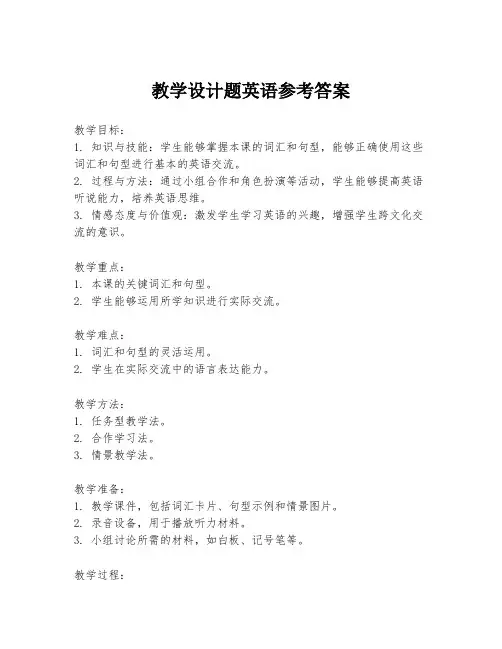
教学设计题英语参考答案教学目标:1. 知识与技能:学生能够掌握本课的词汇和句型,能够正确使用这些词汇和句型进行基本的英语交流。
2. 过程与方法:通过小组合作和角色扮演等活动,学生能够提高英语听说能力,培养英语思维。
3. 情感态度与价值观:激发学生学习英语的兴趣,增强学生跨文化交流的意识。
教学重点:1. 本课的关键词汇和句型。
2. 学生能够运用所学知识进行实际交流。
教学难点:1. 词汇和句型的灵活运用。
2. 学生在实际交流中的语言表达能力。
教学方法:1. 任务型教学法。
2. 合作学习法。
3. 情景教学法。
教学准备:1. 教学课件,包括词汇卡片、句型示例和情景图片。
2. 录音设备,用于播放听力材料。
3. 小组讨论所需的材料,如白板、记号笔等。
教学过程:Step 1: Warm-up (5 minutes)- Greet the students and ask them about their day to create a comfortable atmosphere.- Play a short English song related to the topic to engage the students.Step 2: Presentation (10 minutes)- Introduce the new vocabulary and phrases using visual aids and examples.- Elicit the meaning of the new words from the students and provide feedback.Step 3: Practice (15 minutes)- Organize students into small groups and give them a list of sentences to complete using the new vocabulary.- Walk around the classroom to provide assistance and monitor their progress.Step 4: Production (15 minutes)- Present a scenario for a role-play activity where students need to use the new vocabulary and phrases.- Allow students to prepare their role-plays and then perform them in front of the class.Step 5: Consolidation (10 minutes)- Conduct a quick quiz to reinforce the new vocabulary and phrases.- Provide immediate feedback and clarify any misunderstandings.Step 6: Summary (5 minutes)- Summarize the key points of the lesson and highlight the importance of the vocabulary and phrases.- Encourage students to practice using the new language outside of class.Step 7: Homework (5 minutes)- Assign homework that includes writing a short paragraph using the new vocabulary and phrases in a context of their choice.Assessment:- Formative assessment will be conducted through class participation, role-play performances, and the completion of the practice sentences.- Summative assessment will be based on the homework assignment and a follow-up test.Differentiation:- Provide additional support to students who struggle with the new vocabulary through one-on-one assistance oradditional practice materials.- Challenge advanced students with more complex sentences or additional vocabulary related to the topic.Reflection:- Reflect on the effectiveness of the lesson and consider any adjustments needed for future lessons.- Seek feedback from students on their understanding and engagement with the lesson.Conclusion:This lesson plan aims to provide a comprehensive approach to teaching English vocabulary and phrases, ensuring that students not only understand the language but also have the opportunity to use it in meaningful ways. The inclusion of various activities caters to different learning styles and promotes active engagement in the learning process.。
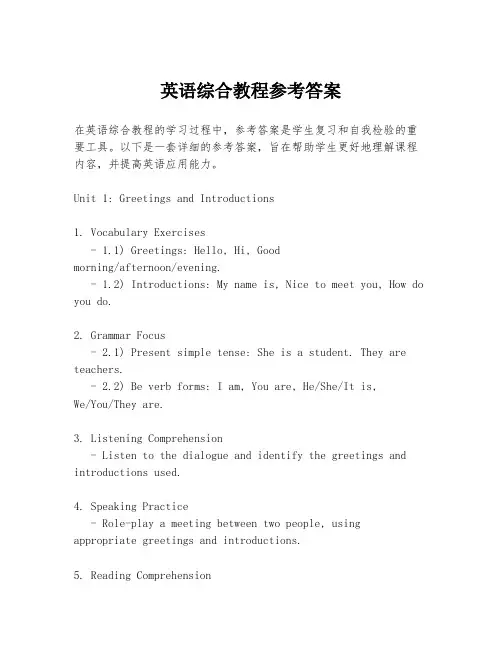
英语综合教程参考答案在英语综合教程的学习过程中,参考答案是学生复习和自我检验的重要工具。
以下是一套详细的参考答案,旨在帮助学生更好地理解课程内容,并提高英语应用能力。
Unit 1: Greetings and Introductions1. Vocabulary Exercises- 1.1) Greetings: Hello, Hi, Goodmorning/afternoon/evening.- 1.2) Introductions: My name is, Nice to meet you, How do you do.2. Grammar Focus- 2.1) Present simple tense: She is a student. They are teachers.- 2.2) Be verb forms: I am, You are, He/She/It is,We/You/They are.3. Listening Comprehension- Listen to the dialogue and identify the greetings and introductions used.4. Speaking Practice- Role-play a meeting between two people, using appropriate greetings and introductions.5. Reading Comprehension- Read the passage about different ways to greet people in various cultures and answer the questions.6. Writing Task- Write a short paragraph introducing yourself to a new classmate.Unit 2: Daily Routines1. Vocabulary Exercises- 1.1) Daily activities: Wake up, brush teeth, have breakfast, go to school/work.- 1.2) Time expressions: At, in themorning/afternoon/evening, on time, late.2. Grammar Focus- 2.1) Present continuous tense: She is having breakfast. They are going to school.- 2.2) Adverbs of frequency: Always, usually, sometimes, never.3. Listening Comprehension- Listen to the descriptions of daily routines and match them with the correct person.4. Speaking Practice- Discuss your daily routine with a partner and ask questions about theirs.5. Reading Comprehension- Read about different daily routines of people fromaround the world.6. Writing Task- Write a diary entry describing your typical day.Unit 3: Food and Dining1. Vocabulary Exercises- 1.1) Food items: Apple, pizza, rice, steak.- 1.2) Dining expressions: Order, serve, enjoy, delicious.2. Grammar Focus- 2.1) Present perfect tense: I have eaten. They have tried.- 2.2) Modal verbs: Can, could, may, might.3. Listening Comprehension- Listen to a conversation at a restaurant and note the food ordered.4. Speaking Practice- Practice ordering food at a restaurant with a partner.5. Reading Comprehension- Read about various types of cuisine from around the world.6. Writing Task- Write a review of a restaurant you recently visited.Unit 4: Travel and Transportation1. Vocabulary Exercises- 1.1) Modes of transportation: Car, train, plane, bus.- 1.2) Travel phrases: Departure, arrival, ticket, luggage.2. Grammar Focus- 2.1) Future simple tense: I will travel. They will go.- 2.2) Future continuous tense: She will be traveling.They will be arriving.3. Listening Comprehension- Listen to travel plans and identify the mode of transportation used.4. Speaking Practice- Discuss your ideal vacation and how you would get there.5. Reading Comprehension- Read about different travel destinations and their attractions.6. Writing Task- Write a travel itinerary for a trip you would like to take.Unit 5: Work and Career1. Vocabulary Exercises- 1.1) Job titles: Teacher, doctor, engineer, manager.- 1.2) Workplace expressions: Interview, promotion, office, project.2. Grammar Focus- 2.1) Passive voice: The project is managed by her. The interview will be conducted.- 2.2) Conditional sentences: If I get the job, I willmove to a new city.3. Listening Comprehension- Listen to job interviews and identify the qualifications of the candidates.4. Speaking Practice- Role-play a job interview with a partner.5. Reading Comprehension- Read about different career paths and their requirements.6. Writing Task- Write a cover letter for a job application.Unit 6: Hobbies and Interests1. Vocabulary Exercises- 1.1) Hobbies: Reading, painting, playing。

《Lesson 4》教学设计一、教学目标1、知识与技能目标学生能够掌握本节课的重点词汇和短语,如_____、_____、_____等。
学生能够理解并运用本节课的重点句型,如_____、_____等,进行简单的交流和表达。
2、过程与方法目标通过听力、阅读、口语和写作等多种语言技能的训练,提高学生的综合语言运用能力。
引导学生通过小组合作、角色扮演等活动,培养学生的合作学习能力和语言实践能力。
3、情感态度与价值观目标激发学生学习英语的兴趣,增强学生的学习自信心。
培养学生的跨文化意识,了解不同文化之间的差异。
二、教学重难点1、教学重点重点词汇和短语的掌握与运用。
重点句型的理解和正确运用。
2、教学难点如何引导学生在实际情境中灵活运用所学知识进行交流和表达。
帮助学生理解一些复杂的语法结构和语言现象。
三、教学方法1、任务驱动法通过布置各种任务,如听力任务、阅读任务、写作任务等,让学生在完成任务的过程中掌握知识和技能。
2、情景教学法创设真实的语言情境,让学生在情境中感受语言的实际运用,提高语言运用能力。
3、合作学习法组织学生进行小组合作学习,共同完成学习任务,培养学生的合作精神和团队意识。
四、教学过程1、导入(Warming up)通过播放一段与本节课主题相关的英语视频或歌曲,引起学生的兴趣,导入新课。
与学生进行简单的日常交流,如询问学生最近的学习和生活情况,引导学生用英语回答,从而复习之前学过的知识,为新课的学习做好铺垫。
2、词汇学习(Vocabulary)展示本节课的重点词汇和短语,通过图片、实物、动作等方式帮助学生理解其含义。
带领学生朗读词汇,纠正发音,让学生掌握正确的读音。
组织学生进行词汇练习,如词汇填空、单词拼写等,巩固所学词汇。
3、句型学习(Sentence patterns)讲解本节课的重点句型,通过举例、对比等方式帮助学生理解句型的结构和用法。
让学生模仿例句进行句型操练,鼓励学生积极参与,大胆表达。
大学英语教材答案综合训练大学英语教材综合训练答案Unit 1: Listening ComprehensionSection A:1. B) The woman is talking about her trip to a foreign country.2. C) He was ill and had to go to the hospital.3. A) He failed to prepare for the exam properly.4. D) It will start in two weeks.5. B) They forgot to bring their umbrellas.6. C) He is occupied with his work.7. D) He is an experienced applicant.8. A) He was waiting for the bus driver to help him.9. B) She prefers listening to music rather than watching movies.10. C) By asking the waiter to bring another one.Section B:11. elderly12. reliable13. globally14. utterly15. commit16. tremendous17. critical18. confront19. clumsy20. eliteSection C:21. D) Attend an English course.22. C) They want to improve their English skills.23. B) He is unfamiliar with the business vocabulary.24. A) Designing a new product.25. C) They will have a test the next day.Unit 2: Reading ComprehensionSection A:26. A) lack of experience27. D) by following your passion28. B) They may underestimate the necessary skills and experiences.29. A) having a strong sense of responsibility30. C) It helps broaden their horizons and gain practical skills.Section B:31. D) The importance of global warming.32. B) Fossil fuels.33. C) Fourth.34. D) Climate change.35. A) It has a long history of public activism.36. C) It is a unique opportunity for people to express their concerns.37. B) By attending protests and signing petitions.38. A) It can raise public awareness and force governments to act.39. D) It calls for rapid and sustained reductions in greenhouse gas emissions.40. C) The participation of people from all walks of life.Unit 3: Vocabulary and GrammarSection A:41. C) has been42. A) lasted43. D) had been waiting44. C) were injured45. B) were playing46. D) will take47. B) has been renovated48. A) having49. C) had seen50. B) had been studyingSection B:51. C) in52. A) to53. D) since54. B) on55. C) for56. A) by57. D) through58. B) without59. C) over60. D) amongUnit 4: Translation61. It is necessary to have a good command of English in today's globalized world.62. You should take advantage of the opportunity to study abroad.63. The company is looking for a candidate who is fluent in both English and French.64. Learning a foreign language requires patience and persistence.65. I regret not practicing speaking English more often when I was in college.Unit 5: Writing66. (Sample answer) In my opinion, the Internet is a double-edged sword. On the one hand, it has greatly facilitated our lives. With just a few clicks, we can access a vast amount of information and connect with people fromall over the world. The Internet has also revolutionized industries such as e-commerce and online education, providing convenience and opportunities for many. On the other hand, the Internet also poses various risks and challenges. Privacy breaches, cyberbullying, and addiction to social media are just a few examples. Therefore, it is crucial for us to use the Internet mindfully and responsibly, taking necessary precautions to protect our personal information and maintaining a healthy balance between online and offline activities.67. (Sample answer) Different people have different preferences when it comes to choosing their ideal travel destinations. Some may prefer relaxing on a tropical beach, soaking up the sun and enjoying the gentle breeze. Others may be fascinated by historical sites and ancient cultures, eager to explore the remnants of civilizations past. Some may seek adventure and adrenaline rushes, opting for activities such as hiking, bungee jumping, orskydiving. For nature lovers, national parks and wildlife reserves offer a chance to immerse themselves in the beauty of the natural world. Ultimately, the choice of a travel destination depends on one's interests, preferences, and the experiences they seek.(Note: This answer includes two sample essays for the writing section)以上为大学英语教材综合训练的答案。
《教师课堂教学技能培养与训练》在线自测题第一章教师课堂教学技能及训练的基本概念单项选择题:1、教师课堂教学技能训练的方法,国内外普遍流行和采用的主要有:、实习教学法和教学实践法三类。
(微格教学法、师资培训、进修培训、在岗培训)2、教学技能的内容主要内容包括:(6大方面)进行教学设计的技能;使用教学媒体和编制教学软件的技能;;课堂教学的技能;设计和批改作业的技能;组织和指导学科课外活动的技能;教学研究的技能。
(组织教学技能、课堂教学的技能、语言表达、教学方法)3、技能在教育心理学中是指顺利完成某种任务的一种活动方式或心智活动方式。
它是通过练习获得的,技能分为动作技能和。
(心智技能、知识理解、课程设计、操作技能)4、是为顺利完成某项任务而合理组织起来的实际动作。
例如,画图、编制、游泳、艺术体操、驾驶汽车等。
(组织技能、动作技能、课堂控制技能、语言技能)5、教学技能的内涵中的能力层面,主要是指教师对技术层面的操作规程、、要求要领的主观掌握和应用并形成熟练的教学能力的行为方式。
(思维模式、方式方法、策划设计、教学方法)多项选择题:1、课堂教学技能是教师教学六大技能中最重要的一种技能,是指在课堂教学中,依据教学理论,运用专业知识,顺利完成教学任务并能促进学生学习发展,而采取的一系列教学行为方式。
具体讲课堂教学技能包括:导入技能、板书技能、、讲解技能、提问技能、、结束技能、组织技能、变化技能、语言技能、信息技术应用技能等。
(教案设计、演示技能、反馈和强化技能、多媒体课件制作)2、教学技能的内涵包含三个层面:1) 2)能力层面 3)(知识掌握层面、能力层面、教案设计层面、创造性和艺术化运用技术层面)3、一个完整的微格训练,其流程如下:1)确定训练日标2)学习和研究教学技能3)4)编写教案5)教学技能实践 6) 7)讨论评价,修改教案 8)再实践。
(录象;提供教学技能的示范;重放录像,自我分析;讨论)4、课堂教学技能的技术层面主要指基本的操作规程和方法要领。
基础综合英语教师手册课后练习题含答案简介基础综合英语是大多数英语学生的入门课程。
这门课程旨在让学生打下语言基础,包括词汇、语法、听力、口语和阅读理解等方面。
作为英语教师,你需要掌握基础综合英语的教学内容,同时也要为学生提供充足的练习机会。
因此,提供一份基础综合英语教师手册,包括课后练习题和答案,对提高学生的英语基础水平非常有帮助。
本手册所提供的练习题不仅能够帮助教师们更好地检验学生的掌握情况,同时也能够让学生更好地自我学习和提高。
课后练习题目录词汇相关1.下列哪个单词的反义词是“grant”?–A. Recover–B. Deny–C. Dedicate–D. Associate答案:B2.下列哪个单词是动词?–A. Convenient–B. Hour–C. Manage–D. Benefit答案:C3.填空。
The ______________ in the garden is growingquickly.答案:grass语法相关1.下列哪个句子使用的动词是不正确的?–A. I is always happy to see you.–B. She always wears a beautiful dress.–C. We have been wting for you for an hour.–D. They are singing loudly in the park.答案:A2.下列哪个句子是正确的?–A. She drinks neither milk or coffee.–B. He ate either pasta nor salad for dinner.–C. I will go to the beach or the pool today.–D. We can’t decide between volleyball nor soccer.答案:C阅读理解根据以下文章回答问题。
2024年教师资格考试初中英语学科知识与教学能力自测试题与参考答案一、单项选择题(本大题有30小题,每小题2分,共60分)1、The teacher encouraged the students to__________their creative thinking in the project.A. put onB. bring outC. get throughD. go along答案:B解析:本题考查动词短语辨析。
put on意为“穿上,上演”;bring out意为“展现,发表”;get through意为“通过,接通”;go along意为“前进,进展”。
根据句意,B选项符合题意,表示鼓励学生在项目中展现他们的创造性思维。
因此,答案为B。
2、In order to promote the students’ __________, the teacher organized a series of activities in the classroom.A. communicationB. cooperationC. competitionD. education答案:C解析:本题考查名词辨析。
communication意为“沟通”;cooperation意为“合作”;competition意为“竞争”;education意为“教育”。
根据句意,教师为了促进学生之间的竞争,组织了一系列的课堂活动。
因此,C选项符合题意。
答案为C。
3、The sentence “She has two cats, one of which is black and the other white.” is an example of:A) a simple sentenceB) a compound sentenceC) a complex sentenceD) a compound-complex sentenceAnswer: C) a complex sentenceExplanation: The sentence is complex because it contains a main clause (“She has two cats”) and a dependent clause (“one of which is black and the other w hite”) that provides additional information about the subject of the main clause.4、In the following sentence, the word “therefore” is used to:A)provide a causeB)show a contrastC)give an exampleD)indicate a resultAnswer: D) indicate a resultExplanation: The word “therefore” is a conjunction that is used to introduce a result or consequence, indicating that one thing is a direct outcomeof another. In the sentence, “Therefore, she decided to study harder,” it shows that the decision to study harder is a result of some previous event or situation.5、The following sentence is written in passive voice. Which sentence is the correct active voice version?A. The cake was made by my mother last night.B. My mother made the cake last night.C. The cake was baking in the oven.D. The cake was baked by my mother.Answer: BExplanation: The original sentence is in the passive voice, using “was made.” To convert it into active voice, the subject of the passive voice (the cake) becomes the subject of the active voice, and the verb is changed to the active form (“made”). Therefore, the correct active voice version is “My mother made the cake last night.”6、Choose the word that best completes the following sentence:The students were eager to learn about the___________of the new technology.A. principlesB. basicsC. mechanismD. fundamentalsAnswer: AExplanation: The word “principles” in this context refers to the fundamentaltruths or basic ideas on which something is based. It fits well with the sentence, which is about the basic ideas behind the new technology. The other options, “basics,” “mechanism,” and “fundamentals,” could be used in different contexts, but “principles” is the most appropriate choice for the sentence provided.7、The following sentence is an example of which type of sentence structure?A. SimpleB. CompoundC. ComplexD. Compound-complexAnswer: CExplanation: A complex sentence has an independent clause and at least one dependent clause. In the sentence “Although she had been studying for hours, she still failed the exam,” “Although she had been studying for hours” is the dependent clause, and “she still failed the exam” is the independent clause.8、Which of the following words is the opposite of “converge”?A. DivergeB. ConvergeC. ConsistD. IntegrateAnswer: AExplanation: “Converge” means to come together or move towards a common point or center. The opposite of this is “diverge,” which means to move apart or to develop differently. Therefore, the cor rect answer is “Diverge.”9.The teacher is demonstrating a new grammar structure to the students. Which of the following activities is most appropriate for practicing this structure immediately after the demonstration?A)Role-play a dialogue using the new grammar structure.B)Complete a fill-in-the-blanks activity with the new grammar structure.C)Translate sentences from English to Chinese and back.D)Answer multiple-choice questions about the new grammar structure.Answer: A)解析:在演示了新的语法结构之后,角色扮演是一种非常有效的实践活动,因为它允许学生在一个真实语境中使用新学的语法,从而巩固和练习这一结构。
2023年教师资格之中学英语学科知识与教学能力练习题(一)及答案单选题(共30题)1、Cold and hot are called______ antonyms.plementaryB.gradableC.homophonesD.converse【答案】 B2、Through doing this, the teacher will be able to ascertain the extent to __________the children understand what they are reading.A.how ?B.whichC.that ?D.what【答案】 B3、When the Viaduct de Millau opened in the south of France in 2004, this tallest bridge in the world won worldwide accolades. German newspapers described how it “floated above the clouds” with “elegance and lightness” and “breathtaking” beauty. In France, papers praised the “immense” “concrete giant.” Was it mere coincidence that the Germans saw beauty where the French saw heft and power? Lera Borodisky thinks not. In a series of clever experiments guided by pointed questions, Boroditsky is amassing evidence that, yes, language shapes thought. The effect is powerful enough, she says, that “the private mental lives of speakers of different languages may differ dramatically,” not only when they are thinkingin order to speak, “but in all manner of cognitive tasks,”including basic sensory perception. “Even a small fluke of grammar”—the gender of nouns—“can have an effect on how people think about things in the world,” she says.A.The gender of nouns affects how people think about things in the worldB.Germans and Frenchmen think differently about the Viaduct de Millaunguage shapes our thoughts and affects our perception of the worldD.There are different means of proving how language shapes our thoughts【答案】 C4、请阅读Passage l。
小学教案题库及答案教案题库及答案:小学英语-动词时态练习教学目标:1. 学生能够理解并正确使用英语动词的基本时态,包括一般现在时、一般过去时和一般将来时。
2. 学生能够根据句子中的语境,正确选择并运用适当的动词时态。
教学准备:1. 复习用的绘本或图片2. 课堂白板或展示屏3. 小学生英语学习用书4. 小组或个人练习题卷教学过程:一、导入(5分钟)1. 向学生展示一些图片或绘本,让学生用英语描述上面的人或动物在做什么。
例如:The boy is playing football. The cat is sleeping, 等等。
二、讲解动词时态(15分钟)1. 教师通过例句向学生介绍一般现在时、一般过去时和一般将来时的用法和标志词。
2. 请学生跟读例句,并注意时态变化的规律。
三、练习时态转换(15分钟)1. 教师提供一份时态转换练习题,要求学生根据给出的动词,将其变换成不同的时态。
2. 学生完成练习题后,教师逐个检查答案,并就错误的地方给予指导。
四、选择题练习(15分钟)1. 教师提供一份选择题练习题,要求学生根据句子中的语境,选择正确的动词时态。
2. 学生独立完成练习题后,教师进行答案讲解,解释每个选项的误区。
五、小组合作活动(10分钟)1. 将学生分成小组,每个小组选择一位代表。
2. 教师给出一些句子,代表们轮流阅读句子并根据语境选择正确的动词时态。
3. 教师记录每个小组的得分,并表扬表现优秀的小组。
六、综合练习(10分钟)1. 教师提供一份综合练习题,要求学生根据句子中的语境,正确填写动词的正确时态形式。
2. 学生独立完成练习题后,教师逐个检查答案,并解释出现错误的原因。
七、课堂总结(5分钟)1. 教师与学生一起回顾今天所学的英语动词时态。
2. 教师对学生的表现给予鼓励和肯定,并提出需要注意的问题。
八、作业布置(2分钟)1. 教师布置一些关于动词时态的作业,要求学生自己完成,并在下节课交上。
英语教学设计与技能训练综合练习及答案
填空题
1.教学系统的四要素是___________ ___________ ____________ ___________
2. 教学设计的前期分析是指___________ ___________ ____________
3.教学评价的对象是___________ ___________ ____________。
4.学习者起点能力的分析包括__________ ___________ ____________ 。
5.教学评价的功能_________ ___________ ____________ ___________。
6.教学组织形式包括__________ ___________ ____________ 。
7.学习内容分析的步骤包括_________ ___________ ____________ ___________ __________。
8.教学评价的原则_________ ___________ ____________ ___________ __________。
答案:
1.学生、教学目标、教学策略、教学评价
2.学习需要分析、学习内容分析、学习者分析
3.课程材料的评价、教师授课质量评价、学生学业成就评价
4.学习者认知能力的分析、学习者技能起点的分析、学习者态度能力的分析
5.导向功能、调控功能、诊断功能、激励功能
6.集体授课、个别化学习(自学)、小组相互作用
7.学习内容分析的步骤:组织和选择单元、确定单元目标、确定学习任务、分析学习任务、评价
8.目的性原则、客观性原则、整体性原则、指导性原则、科学性原则
简答题
1.教学设计
2.教学的阶段包括哪些?
3.学习需要
4.学习的阶段
5.学习风格
6.教学策略
答案
1.运用系统方法分析教学问题和确定教学目标、建立解决教学问题的策略方案、试行解决方案、评价试行结果和对方案进行修改的过程。
它以优化教学效果为目的,以学习理论、教学理论和传播学为理论基础。
2.
1.引起注意
2.告知学习者目标
3.激活相关的原有知识
4.呈现刺激材料
5.提供学习指导
6.引发学习行为
7.提供反馈
8.评估学习行为
9.促进记忆与迁移
3.学习需要:指学习者学习方面当前的状况与被期望达到的状况之间的距离,或者说学习者已经具备的水平与期望学习者达到的水平之间的差距。
4.动机阶段、领会阶段、习得阶段、保持阶段、回忆阶段、概括阶段、作业阶段、反馈阶段
5.:学习风格是指对学习者感知不同刺激并对不同刺激作出反应。
这两个方面产生影响的所有心理特性。
学习风格包括学习者在信息接受加工方面的不同方式;对学习环境和条件的不同需求;在认知方面的差异,某些个性意识倾向性因素;生理类型的差异。
6.教学策略是为达到教学目标,完成教学任务,而在对教学活动清晰认识的基础上,对教学活动进行调节和控制,并选择运用恰当的教学媒体所使用的方法或方式的总称。
论述题
1.论述学习需要与学习需要分析之间的关系?
答案:
1.学习需要:指学习者学习方面当前的状况与被期望达到的状况之间的距离,或者说学习
者已经具备的水平与期望学习者达到的水平之间的差距。
2.学习需要分析:是一个系统化的调查研究过程,这个过程的目的就是要揭示学习需要
从而发现问题,通过分析问题产生的原因确定问题的性质,并辩明教学设计是否是解决这个问题的合适途径;其实质就是分析教学设计的必要性和可行性。
学习需要与学习需要分析的关系:
要找到学习需要,就必须分别确定期望学生达到的学习状况和他们目前的学习状况。
这个分析过程就是学习需要分析。
学习需要分析的作用就是鉴定教学问题,并在此基础上形成总的教学目标,为分析学习内容、编写学习目标、制定教学策略选择和运用教学媒体以及进行教学评价等各项教学设计工作提供真实的依据。
2.如何理解教学设计
答案:
教学设计:运用系统方法分析教学问题和确定教学目标、建立解决教学问题的策略方案、试行解决方案、评价试行结果和对方案进行修改的过程。
它以优化教学效果为目的,以学习理论、教学理论和传播学为理论基础。
对于教学设计的理解要从以下几个方面去理解:教学设计的目的、教学设计的研究对象、教学设计的研究方法、教学设计的结果、教学设计的一般步骤。
要理解教学设计的模式,还要意识到充分发挥教学系统的整体效应。
认识教学系统的四要素:学生、目标、策略、评价要认识到教学过程是动态过程,教学系统是开放系统,教学设计是灵活的、充满创造性的过程。
3.论述学习过程中的领会阶段?
答案:
有了学习动机的学生,首先必须注意与学习有关的刺激。
注意的过程一般被认为是一种暂时的内部状态,或被称为心理定势。
一旦注意某种刺激后,它就起一种控制执行过程的作用,即只对某些刺激予以加工。
注意定势是由外部刺激激活的,注意的时间因人因事而不同。
教师可以采用多种手段来引起学生注意。
学生把所注意的刺激特征从其他刺激中分化出来时,这些刺激特征就被进行知觉编码,储存在短时记忆中。
这个过程就是选择性知觉。
Please copy the combinations of letters with the standard handwriting..
oa ap so fa
ni dy ff og
Please copy the following words with the standard handwriting.
four Singapore London his work
pass zinc candle cart
Please copy the following sentences with the standard handwriting. .
1.Mind your head!
2.Please wait for your turn.
3.Autumn is a busy season.
Please copy the short passage with the standard handwriting.
How time flies! Twenty days ago we were happily here in this hall to give Prof. Smith a warm welcome. Now he has concluded his tour in our country, and he will leave for home tomorrow.
Please copy the combinations of letters with the standard handwriting. oc ip as fe
no ay fi vi
Please copy the following words with the standard handwriting.
six France Romania Tokyo pay
axe plain crown iron tools
Please copy the following sentences with the standard handwriting. 1. No smoking, please.
2. That’s my opinion.
3.Spring is the best season of the year.
Please copy the short passage with the standard handwriting.
Prof. Smith is our old friend. During his short stay in China, he has carefully studied our education and given us a lot of good advice and valuable suggestions on our education.
Please copy the combinations of letters with the standard handwriting.
om mp ls te
ny fo ft ou
Please copy the following words with the standard handwriting.
ten Germany Paris China
Laos Beijing Peru hot
Please copy the following sentences with the standard handwriting.
1.How are you?
2.Jim is my classmate.
3.Boys and girls often go skating.
Please copy the short passage with the standard handwriting.
Spring is here now. It is sunny and warm today. There are many people over there. They are students, teachers and workers. The boys near the river are digging. They are all busy planting trees.。